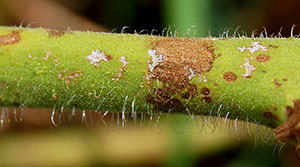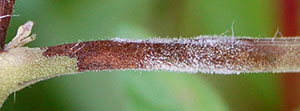Late blight: How do I fix it?
Late blight is a devastating fungus disease of tomatoes and potatoes. Our previous blog, Late blight: What does it look like?, showed you how to identify it. Here, we show you how to deal with it.
Prevention is the best way to manage late blight. And knowing the life cycle of the fungus helps you figure out ways to prevent it. If you can disrupt the fungus life cycle, you can protect your plants.
The late blight fungus (Phytophthora infestans), like many other fungi, produces millions of airborne spores that drift on the breeze. When they settle on a susceptible host plant (leaf, stem, or fruit), the spores germinate and the fungus begins to grow down into the plant’s tissues. The fungus digests the cells of the host plant as it grows, first turning them black and then brown as the cells die. The initial spots are small, but they grow larger, quickly engulfing the entire leaf. The leaf wilts and dies, hanging on to the sick plant. Soon, the entire plant dies and the fruit is ruined.
Each spot on leaves and stems produces millions of microscopic spores that look like cottony white fuzz. Each tiny spore is a potential new infection that can devour healthy tissue. These spores are carried to healthy plants by wind, wind-driven rain, irrigation water, tools, and gardeners. If the weather is cool and moist, the disease spreads rapidly through many plants in the nightshade family (Solanaceae: tomatoes, potatoes, peppers, and eggplants, for example).
The key to protecting your plants from late blight is to kill the spores and disrupt the life cycle of the fungus. If you can prevent the spores from germinating and infecting your plants, you can control this disease.
To keep healthy plants free of this disease, protect them with products certified for use on organic food crops. Neem oil, copper, and sulfur, for example, are chemicals that create conditions on the surface of leaves, stems, and fruit that prevent late blight spores from germinating. Read the labels to learn how to use each product. Check your tomato plants (and their relatives) once a week for symptoms. This disease spreads quickly, so be vigilant.
Sadly, no cure exists for this disease once your plant becomes infected. No magic bullet exists; not even modern synthetic fungicides can cure a plant with late blight. However, there are still some things you can do if your plants get sick.
For slightly infected plants – those with only a few lesions (spots) on leaves or stems – you must protect the remaining healthy leaves.
First, spray Neem oil, copper, or sulfur, and allow the plants’ foliage to dry.
Second, sanitize by removing infected tissue from the plants, the ground, and your entire garden.
Third, put all the infected material into a plastic bag, seal it, and discard it in the trash. Do not compost it. You will have to be vigilant and search for new infections every day. You will also need to apply the spray again, especially if rain washes the material off your plants.
For plants seriously ill with late blight you have to pull the plug.
First, pull up the infected plants, roots and all.
Second, put them in a plastic bag and seal the bag tightly.
Third, put the bag in the sun for a couple of days. The sunlight and the heat will help kill the spores.
Finally, discard the plants, with the bag, in a landfill. Do not compost the sick plants. Get rid of them. The fungus can live in your compost pile and will be a source of new infections. Do not put the infected material into a municipal composting system, because you will spread the disease to others.
Late blight fungus can live in the soil and may even overwinter. Next year put unrelated plants where your tomatoes and their relatives were this past summer. Plant some other crop, such as corn, cabbage, or squash, in that location and move your tomatoes to a completely new spot. You may have had a lousy tomato crop this year, but you can always hope for a great season next year.
David Deardorff is a botanist and plant pathologist. Kathryn Wadsworth is a writer and naturalist. Visit their website. They are the authors of “What’s Wrong With My Plant? And How Do I Fix It?” from Timber Press.



Leave a Reply